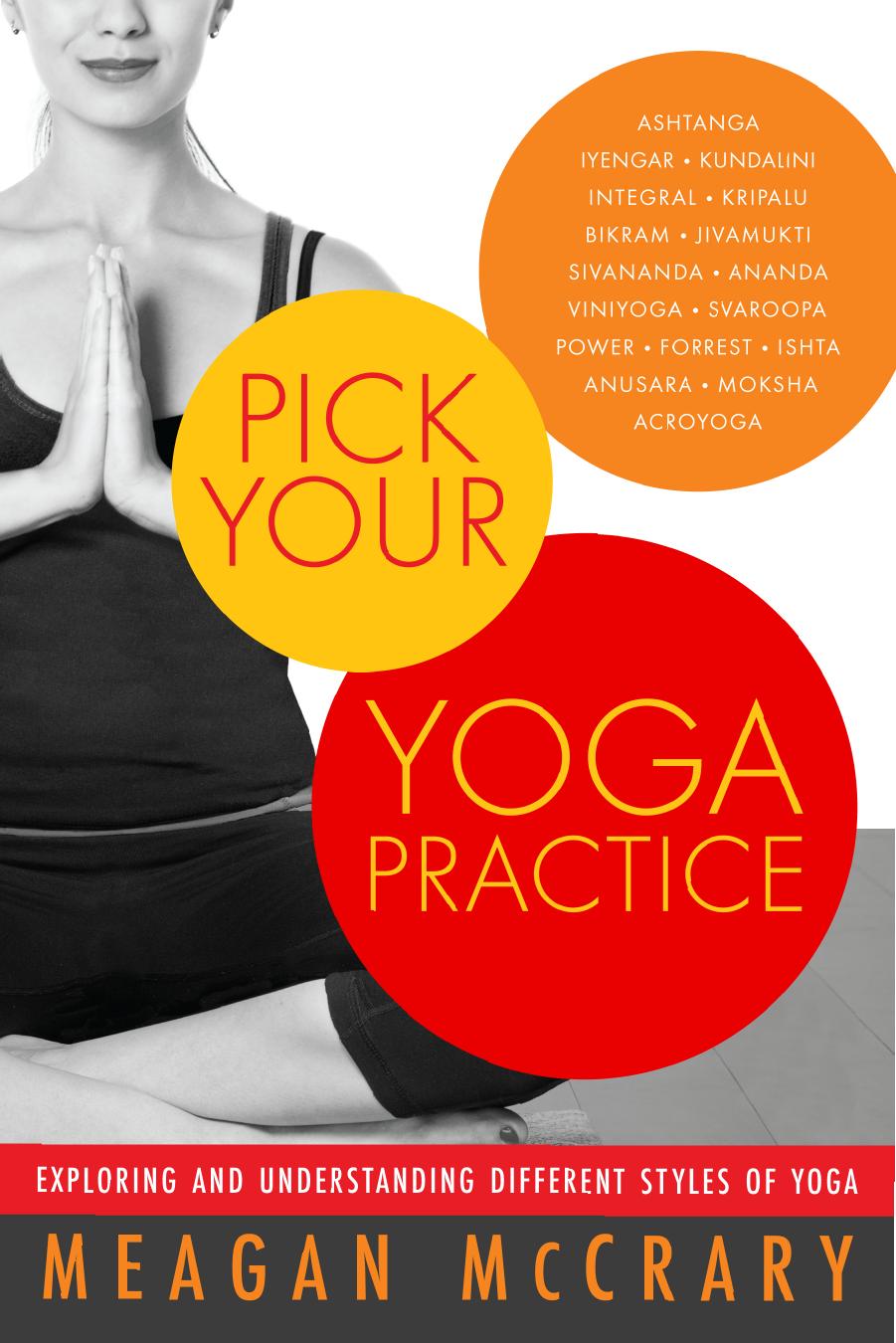Pick Your Yoga Practice: Exploring and Understanding Different Styles of Yoga by McCrary Meagan

Author:McCrary, Meagan [McCrary, Meagan]
Language: eng
Format: epub, mobi, pdf
Published: 0101-01-01T00:00:00+00:00
Integral yoga flow classes are inspired by the vinyasa system; though they
maintain the integrity and principles of classical Integral yoga classes,
they are slightly more rigorous and faster paced. Regardless, the last half
hour or so of any Integral yoga class will always be devoted to the subtler
practices of pranayama, deep relaxation, and meditation.
Yoga Mudra, or Yogic Seal, is the last posture practiced in the asana
routine. This involves sitting in a simple, comfortable cross-legged posi-
tion with your spine erect and softly closing your eyes, taking a few easy,
natural breaths, and directing your awareness within. Once you feel
relaxed, you bring your hands behind your back and lightly grab hold
of the right wrist with your left hand. Inhaling deeply, you slowly exhale
112 Pick Your Yoga Practice
as you hinge forward from the hips, keeping the spine as long as possible
and coming as far forward as is comfortable. Eventually you will come to
rest your forehead on the ground. Releasing all tension in the body, relax
the breath and hold the pose for six or seven rounds of breathing, rising
slowly on an inhalation. Then you sit quietly, resting your palms in your
lap, and observe how you feel. Yoga Mudra ( mudra meaning “gesture” or
“seal”) is meant to help the energetic transition from the physical prac-
tice to the subtler aspects of the full yogic routine, during which you are
invited to reflect on your asana session and become deeply aware of your
mental and physical state as a result of practice thus far.
Integral yoga classes include a period of deep relaxation (generally
as long as fifteen to twenty minutes) known as yoga nidra, or “yogic
sleep.” This involves lying flat on your back with your legs loosely apart
and arms at a comfortable distance from the body, palms facing up, and
your eyes closed. The teacher will instruct you to raise, squeeze, and then
abruptly release either the whole body at once or the major regions of the
body individually. Once the entire body is relaxed and still, he or she will
guide you to bring your awareness to each individual body part, begin-
ning with the toes and soles of the feet, in order to mentally release any
tension you may find. The process generally takes about five minutes, and
once it’s complete you’ll be guided to observe the breath, without manip-
ulating or controlling it in any way. Then you will be invited to observe
your thoughts in the same passive manner, allowing anything that arises
to be acknowledged, without identifying with each thought. Lastly, you’ll
be guided to notice that you are merely the observer of your breath and
thoughts, resting easefully and effortlessly in your own peaceful self in
a conscious state of deep sleep. After about five minutes of silence the
teacher will guide the whole class back to a seated position for pranayama
practice.
YOGA NIDRA
Yoga nidra is an essential practice in Integral yoga for calming the mind
and integrating all the physical and physiological benefits of the preceding
asana practice. Often referred to as a state of conscious deep sleep, yoga
Integral Yoga 113
nidra helps release deeply held tension and unwind the autonomic nervous
system, effectively reducing symptoms of stress and anxiety.
Download
Pick Your Yoga Practice: Exploring and Understanding Different Styles of Yoga by McCrary Meagan.mobi
Pick Your Yoga Practice: Exploring and Understanding Different Styles of Yoga by McCrary Meagan.pdf
This site does not store any files on its server. We only index and link to content provided by other sites. Please contact the content providers to delete copyright contents if any and email us, we'll remove relevant links or contents immediately.
Periodization Training for Sports by Tudor Bompa(8170)
Bodyweight Strength Training by Jay Cardiello(7841)
Born to Run: by Christopher McDougall(7065)
Inner Engineering: A Yogi's Guide to Joy by Sadhguru(6725)
Asking the Right Questions: A Guide to Critical Thinking by M. Neil Browne & Stuart M. Keeley(5635)
The Fat Loss Plan by Joe Wicks(4847)
Bodyweight Strength Training Anatomy by Bret Contreras(4612)
Yoga Anatomy by Kaminoff Leslie(4306)
Dynamic Alignment Through Imagery by Eric Franklin(4118)
Science and Development of Muscle Hypertrophy by Brad Schoenfeld(4089)
ACSM's Complete Guide to Fitness & Health by ACSM(3989)
Exercise Technique Manual for Resistance Training by National Strength & Conditioning Association(3956)
The Four-Pack Revolution by Chael Sonnen & Ryan Parsons(3932)
Bodyweight Strength Training: 12 Weeks to Build Muscle and Burn Fat by Jay Cardiello(3915)
The Ultimate Bodybuilding Cookbook by Kendall Lou Schmidt(3886)
Yoga Anatomy by Leslie Kaminoff & Amy Matthews(3863)
American Kingpin by Nick Bilton(3757)
Nutrition for Sport, Exercise, and Health by Spano Marie & Kruskall Laura & Thomas D. Travis(3715)
Yoga Therapy by Mark Stephens(3703)
